Arkansas << AHR kuhn `saw` >>, one of the Southern States of the United States, is almost evenly divided between the Highlands and the Lowlands. The Highlands area, in northern and western Arkansas, has scenic mountains, forests, free-flowing streams, and land suitable for raising livestock. The Lowlands area includes a plain along the Mississippi River in eastern Arkansas, sometimes called the Delta, and a plain in southern Arkansas. The Delta has some of the richest farmland in the United States, and the southern plain has extensive pine forests. Arkansas is known as The Natural State because of its natural beauty and abundant wildlife.


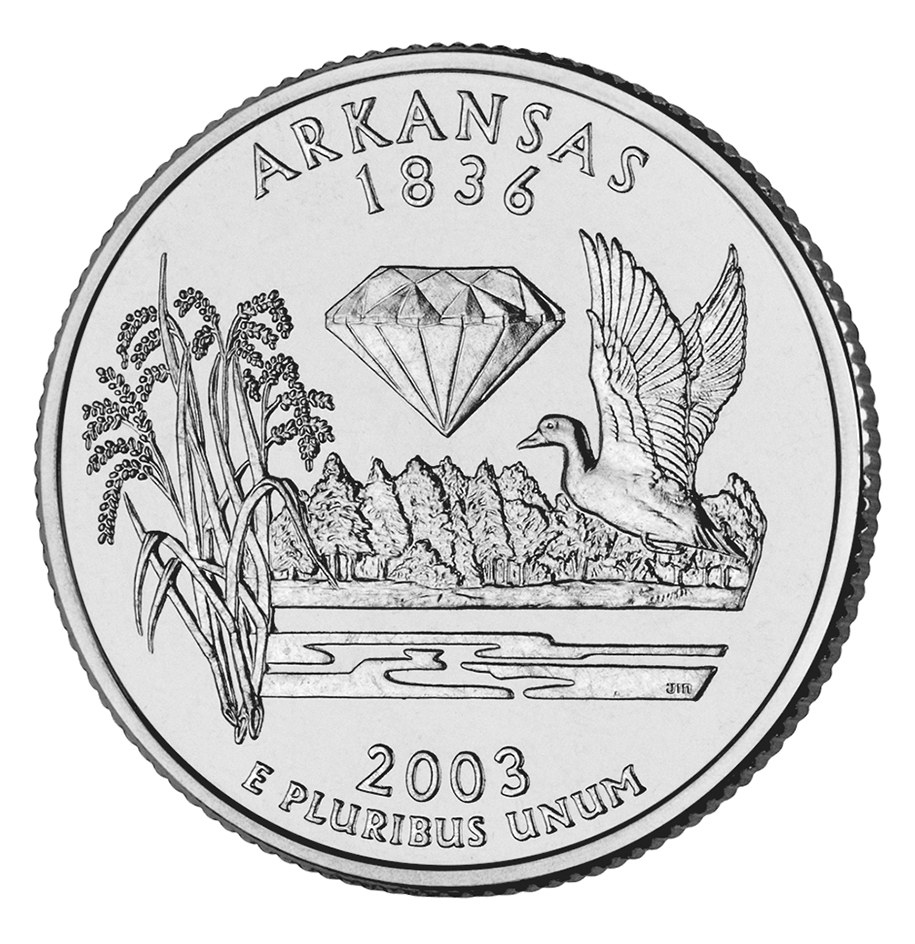
Little Rock is the capital and largest city of Arkansas. The name Arkansas comes from a Native American term for the Quapaw tribe, known as the downstream people.
Millions of tourists visit Arkansas every year. Its clear lakes and streams attract many vacationers who enjoy boating and fishing. Arkansas is famous for its spring waters, which many people believe help cure certain ailments. Mammoth Spring is one of the largest springs in the United States. Hot Springs is a famous health center and a national park. Crater of Diamonds State Park, near Murfreesboro, has a diamond mine open to the public. Tourists sometimes find valuable diamonds there and are permitted to keep their finds.
Food processing is the leading manufacturing industry in the state. The production of primary metal products and transportation equipment is also important. The Fort Smith and Little Rock areas are the leading manufacturing centers. Service industries employ most of the state’s workers. These industries include such activities as education, health care, real estate, retail trade, and transportation. Several large store chains and two leading trucking firms are headquartered in the state.
Farming and mining are also important parts of the economy. Arkansas produces more rice than any other state. It is one of the leading states in raising chickens. Among Arkansas’s mining products, natural gas and petroleum bring in the most income.
Arkansas belonged first to France, then to Spain, and then to France again. The United States acquired the region in 1803. Arkansas was part of the Louisiana Territory until 1812. It then belonged to the Missouri Territory until 1819, when the Arkansaw Territory was established. In 1836, Arkansas became the 25th state of the Union.
People
Population.
The 2020 United States census reported that Arkansas had 3,011,524 people. The state’s population had increased about 3 percent over the 2010 census figure, 2,915,918. According to the 2020 census, Arkansas ranks 33rd in population among the 50 states.
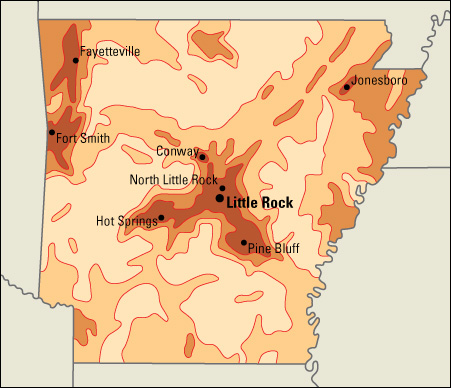
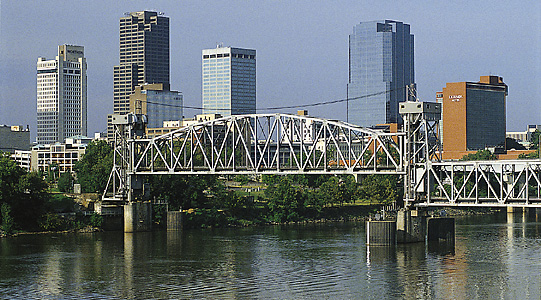
About 60 percent of the people of Arkansas live in metropolitan areas (see Metropolitan area). Four metropolitan areas lie entirely in Arkansas. They are Fayetteville-Springdale-Rogers, Hot Springs, Jonesboro, and Little Rock-North Little Rock-Conway. The Fort Smith metropolitan area extends into Oklahoma. The Memphis (Tennessee) and Texarkana (Texas) areas lie mainly in Tennessee and Texas, respectively.
Little Rock, the state capital, is the largest city in Arkansas. It has a population of about 203,000. Arkansas has eight other cities with a population of more than 50,000. These cities, in order of population, are Fayetteville, Fort Smith, Springdale, Jonesboro, Rogers, North Little Rock, Conway, and Bentonville.
About 15 percent of the people of Arkansas are African Americans. Other large population groups include people of English, German, Irish, Scottish, and Hispanic descent.
Schools.
When Arkansas became a territory in 1819, Congress set aside land in each county for a general school system. In 1820, the Reverend Cephas Washburn established Dwight Mission, the territory’s first school, in Russellville. Washburn and other missionaries taught Cherokee children in Russellville. In 1829, the territorial legislature provided for the construction of schools. 
In 1843, seven years after Arkansas became a state, the legislature provided for a public school system. The 1868 Constitution provided for a system of schools for students between the ages of 5 and 21. A law passed in 1909 required all children between 8 and 16 to attend school. This law now affects children from 5 through 17. Voters in 1948 approved a plan to consolidate the state’s school districts. As a result, the number of districts was reduced from about 1,600 to a little more than 300.
The state Department of Education administers Arkansas’s public school system. The department is governed by the Board of Education. The governor appoints the members of the board. Their appointments are subject to the approval of the state Senate.
The Board of Education, with the approval of the governor, appoints the commissioner of education. For information on the number of students and teachers in the state of Arkansas, see Education (table: U.S. students, teachers, and school expenditures).
Libraries.
In 1843, William Woodruff founded the state’s first subscription library, in Little Rock. Members of this library contributed money to buy books, which they could then use without charge. The Helena Public Library, founded in 1888, became the first tax-supported library in the state. Jefferson County established the state’s first countywide library service in 1926. In 1935, the state legislature created the Arkansas Library Commission. In 1979, the legislature changed the name of the commission to the Arkansas State Library.
Today, Arkansas’s public library system includes county libraries and regional libraries. A number of Arkansas cities also operate their own public libraries. The University of Arkansas in Fayetteville has a large collection of materials on Arkansas and the Civil War.
Museums.
A number of fine museums are in Little Rock. They include the Arkansas Museum of Fine Arts, the Historic Arkansas Museum, the Museum of Discovery, and the Old State House Museum.
Other museums in the state are the Arkansas State University Museum in Jonesboro, the Arts & Science Center for Southeast Arkansas in Pine Bluff, Crystal Bridges Museum of American Art in Bentonville, and the Shiloh Museum of Ozark History in Springdale. The William J. Clinton Presidential Center in Little Rock contains many objects and documents relating to Bill Clinton’s presidency.
Visitor’s guide
Millions of tourists visit Arkansas every year. They enjoy the state’s natural beauty, its many recreational facilities, and its historic sites. Nature lovers are drawn to beautiful caverns, limestone cliffs, forests, mountains, and streams. The state’s mineral and hot spring waters are considered helpful in treating persons with certain illnesses. Hot Springs has the most famous of these springs. The lakes and streams of Arkansas attract people who like fishing, boating, canoeing, and water-skiing. Hunters track black bears, deer, opossum, and raccoons in the southeastern lowlands and elk in the Ozarks. They stalk game birds and waterfowl in the rice marshes near Stuttgart. The Ouachita and Ozark mountain ranges are popular tourist attractions.

The state’s most popular annual events are folk festivals and county fairs. One of the best-known events is the Arkansas State Fair, held in Little Rock in October.
Land and climate
Land regions.
Arkansas has five main land regions: (1) the Ozark Plateau, (2) the Ouachita Mountains, (3) the Arkansas Valley, (4) the Mississippi Alluvial Plain, and (5) the West Gulf Coastal Plain. The Ozark Plateau and the Ouachita Mountains make up the portion of Arkansas known as the Highlands. The Arkansas Valley divides these two highland regions. The Mississippi Alluvial Plain and the West Gulf Coastal Plain make up the Lowlands portion of the state.
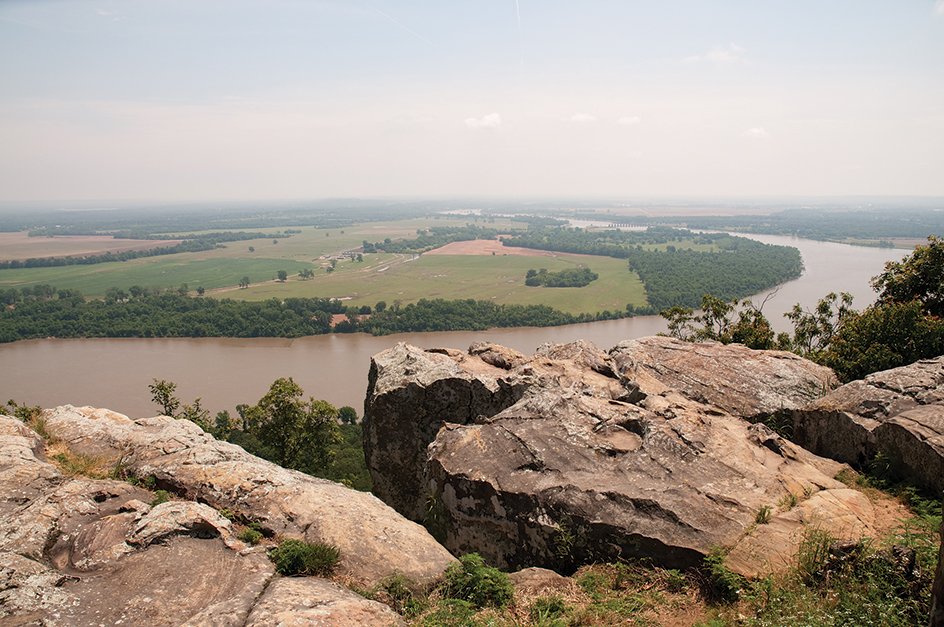
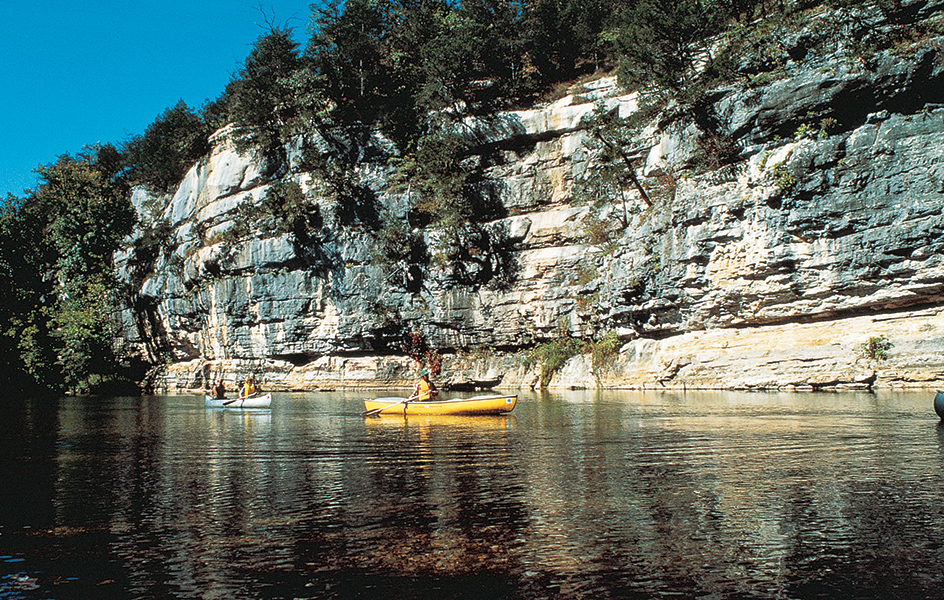
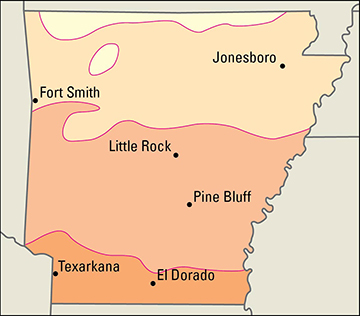
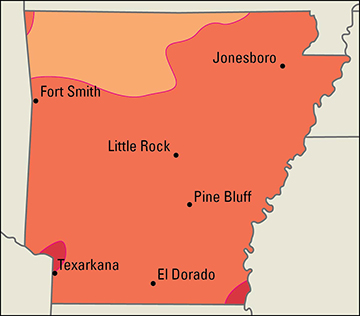
The Ozark Plateau
is a land region that covers parts of Arkansas, Illinois, Missouri, and Oklahoma. This region is often called the Ozark Mountains. In Arkansas, it extends across the northwestern and north-central parts of the state. Rugged hills, deep valleys, and swift streams give the region great beauty. Thick forests and underbrush cover much of the region. Many fruit, livestock, and poultry farms are located in the northeast and northwest sections of the Ozarks. The southern edge of the region has a series of steep, wooded hills called the Boston Mountains. River gorges, 500 to 1,500 feet (150 to 457 meters) deep, wind through these hills.
The Ouachita Mountains
region stretches from eastern Oklahoma to central Arkansas. In Arkansas, it consists of a series of parallel ridges and valleys. Blue Mountain rises 2,623 feet (799 meters). Farmers cultivate some of the land. But the Ouachita region is best known for its timber and mineral resources, and for its hot springs. The Ouachita River flows through the central part of the region before curving south to Louisiana. Dams built along the river have created a chain of lakes.
The Arkansas Valley,
a broad, rolling valley region, lies between the Ozark Plateau and the Ouachita Mountains. The Arkansas Valley is lower than the highland regions to the north and south, but it has several mountain peaks of its own. Magazine Mountain, the highest point in the state, rises 2,753 feet (839 meters) in the Arkansas Valley. The Arkansas River flows through the center of the region southeast into the Mississippi River. Deposits of coal and natural gas lie beneath the region’s fertile fields and pastures.
The Mississippi Alluvial Plain
lies along the Mississippi River. This region extends from Missouri south to Louisiana, and it is sometimes called the Delta. It covers the eastern third of Arkansas. Much of the plain is low, level land, covered with rich deposits of soils carried to the region by the Mississippi River and its tributaries. Most of Arkansas’s major crops are grown in this region. An excellent system of levees and drainage ditches protects the plain from flooding (see Levee). A narrow strip of hills called Crowleys Ridge stretches from north to south through the central part of the Mississippi Alluvial Plain. The ridge is formed of gravel deposits and of wind-blown, yellow mineral particles called loess.
The West Gulf Coastal Plain
covers sizable parts of Arkansas, Louisiana, and Texas. In Arkansas, it is a large, low region in the southwestern and south-central parts of the state. The coastal plain has pine forests, natural gas and petroleum deposits, and beds of bromine salts. Farmers raise livestock and poultry, and grow fruits and vegetables. The lowest point in the state—55 feet (17 meters) above sea level—is near the Ouachita River at the Arkansas-Louisiana border.
Rivers and lakes.
The Mississippi River forms the eastern border of Arkansas. The Arkansas River, the largest river within the state, flows southeast across Arkansas. The McClellan-Kerr Arkansas River Navigation System was completed in 1970. The system allows boats to travel up the Arkansas River from its mouth at the Mississippi River to Tulsa, Oklahoma. Other important rivers in the state include the Ouachita River in south-central Arkansas, the St. Francis River in the east, the Red River in the southwest, and the White River in northern and eastern Arkansas. The unpolluted, free-flowing Buffalo National River is in the Ozarks.
Lake Chicot, the largest natural lake in the state, is an oxbow lake, formed by a river’s changing its course (see Oxbow lake). Several smaller Arkansas lakes were also formed in this manner. A number of large lakes have been created by dams built on Arkansas rivers and streams. A chain of artificially created lakes nestles in the Ouachita Mountains. These include Lakes Catherine, Hamilton, and Ouachita. Lakes along the White River in northern Arkansas include Beaver, Bull Shoals, Norfork, and Table Rock. Big Maumelle Lake and Nimrod Lake lie west of Little Rock.
Springs
in Arkansas are especially plentiful around the foothills of the Ouachita and Ozark mountains. Every year, thousands of people visit the state’s springs in hope that the waters will relieve certain illnesses. Some of the springs contain minerals. Many, however, are known for their purity and their lack of minerals. Eureka Springs in the Ozarks has nearly 65 springs. Mammoth Spring, also in the Ozarks, is one of the largest springs in the United States. About 235 million gallons (890 million liters) of cold water gush from the earth each day. The state’s famous Hot Springs consists of 47 different springs that together yield about 1 million gallons (3.8 million liters) of water a day. The temperature of the water remains constant at about 143 °F (62 °C).
Plant and animal life.
Forests cover about half of Arkansas. The state’s most common trees include ashes, basswoods, buckeyes, elms, hackberries, hawthorns, hickories, hollies, maples, oaks, plums, wild cherries, and willows. Flowering trees include the dogwood, locust, magnolia, red haw, and redbud.
Arkansas has many kinds of wildflowers, including American bellflowers, orchids, passionflowers, water lilies, wild verbenas, and yellow jasmines. Ferns and herbs are plentiful. The fern Woodsia scopulina, which grows on Magazine Mountain, is found nowhere else between the Allegheny and Rocky mountains.
Animal life in Arkansas’s fields and forests includes black bears, bobcats, deer, foxes, gray and red squirrels, and rabbits. Mountainous regions have minks, muskrats, opossums, raccoons, skunks, weasels, and woodchucks. Arkansas has many varieties of game birds, including pheasants, quail, wild ducks, wild geese, wild turkeys, and woodcocks. Common songbirds include the blue jay, brown-headed nuthatch, brown thrasher, cardinal, goldfinch, mockingbird, painted bunting, phoebe, robin, warbler, and whip-poor-will. Reptiles include lizards, turtles, and many kinds of snakes. The lakes, rivers, and streams contain bass, bream, catfish, crappies, drum, perch, pickerel, sturgeon, and trout.
Climate.
Arkansas has a warm, moist climate with warm to hot summers and cool winters. The highlands of northern and western Arkansas are cooler than the lower regions to the south and east. 
July temperatures average 77 °F (25 °C) in northwestern Arkansas and 82 °F (28 °C) in the lowlands. The highland regions are cool at night, even in summer. In January, temperatures average from 36 °F (2 °C) in the northwest to 44 °F (7 °C) in the south and east. The lowlands often have warm, sunny days, even in winter. The state’s highest recorded temperature, 120 °F (49 °C), was at Ozark on Aug. 10, 1936. The lowest recorded temperature, –29 °F (–34 °C), was in Benton County on Feb. 13, 1905.
Yearly precipitation averages about 50 inches (127 centimeters). It ranges from about 42 inches (107 centimeters) in the far north-central region to about 56 inches (142 centimeters) in the core of the Ouachita mountain region. Snowfall in Arkansas averages about 6 inches (15 centimeters) a year. The snow occurs mostly in the highlands.
Economy
Service industries of Arkansas, taken together, account for the largest portion of the gross domestic product—the total value of all goods and services produced in the state in a year. Manufacturing is one of the most important economic activities in Arkansas. Food processing is the state’s leading manufacturing activity.
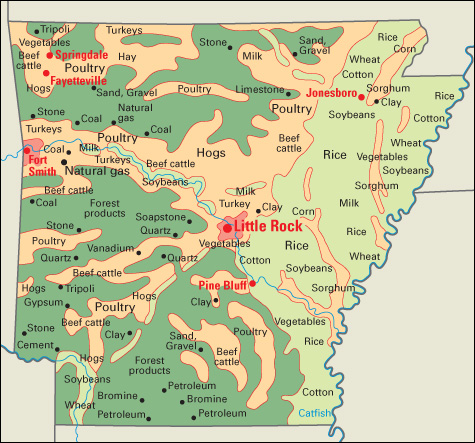
Natural resources
of Arkansas include fertile soils and rich mineral deposits. The state also has thick forests and abundant water.
Soil.
Much of Arkansas has fertile soil. The best farmland lies in the Mississippi Alluvial Plain and in the valleys of the Arkansas and Red rivers. The northern part of the Ozark Plateau has good loamy soils. The southern Ozarks and the Ouachita region have silty and sandy soils. Clay loams mixed with gravel are found in southwest Arkansas. The Crowleys Ridge section of eastern Arkansas has wind-deposited loess soils (see Loess).
Minerals.
The West Gulf Coastal Plain has petroleum deposits. Bituminous (soft) coal and a harder coal called semianthracite come from the Arkansas Valley. Natural gas is also found in parts of the valley. Other mined products include bromine, cement, clays, gemstones, gypsum, limestone, sand and gravel, and tripoli.
Forests
cover about half of the state. Northwest Arkansas has shortleaf pine and hardwood forests. The southwest has forests of loblolly and shortleaf pines. Most of the eastern forests are hardwood.
Service industries
account for the majority of both Arkansas’s employment and its gross domestic product. Most of the service industries are concentrated in the Little Rock area and in other metropolitan areas.
Little Rock, the state capital, is the center of state government activities. Many financial companies and insurance companies also have offices in Little Rock. Many hotels, restaurants, and retail trade establishments operate in the Little Rock area and in northwestern Arkansas. Large hospitals provide medical care in Fayetteville, Fort Smith, Jonesboro, and Little Rock. Little Rock Air Force Base is the largest military installation in Arkansas.
Dillard’s, Inc., a chain of department stores, is based in Little Rock. Walmart Inc., the nation’s largest discount-store chain, is based in Bentonville. Two leading U.S. trucking companies have headquarters in the state. They are J. B. Hunt, in Lowell, and ABF Freight System, Inc., in Fort Smith.
Manufacturing.
Food products are the state’s leading manufactured items. Poultry processing is the leading food-processing activity. Tyson Foods, Inc., based in Springdale, is one of the world’s largest poultry producers and processors. Other Food-processing plants are in Fort Smith, Jonesboro, Little Rock, and other cities.
Fabricated metal products, primary metals products, and transportation equipment are also important manufactured items. Architectural and structural metals are the most valuable types of fabricated metal products made in the state. Aluminum, iron, and steel are the leading types of primary metals. Aircraft parts, motor vehicle parts, and railroad cars are made in Arkansas.
Agriculture.
Farmland covers about two-fifths of the state’s land area. Livestock products provide over half of the farm income. Broilers (young, tender chickens) are the leading farm product. Arkansas is one of the leading states in the production of broilers. Most broilers are raised in the western part of the state.
Beef cattle, dairy products, eggs, hogs, and turkeys are also important livestock products. Beef cattle are raised in most parts of the state. Dairy farming is centered in the Ozark Plateau and near Little Rock. Egg production is heaviest in the northwest corner of the state. Hogs are raised mainly in the western part of the state. Arkansas is a leading state in turkey production.
Crops account for much of the farm income. Cotton, rice, and soybeans are among the most valuable crops grown in Arkansas. The state ranks among the leading cotton-growing states. Cotton is grown primarily in the east. Arkansas is the leading U.S. producer of rice. Rice is grown mainly in the Mississippi Alluvial Plain region in eastern Arkansas. Some farmers flood their rice fields and raise fish in them. Other leading crops include corn, hay, and wheat. Corn and wheat are primarily grown in the east, and hay is important in northwestern Arkansas.
Mining.
Natural gas is the leading mined product of Arkansas. Petroleum ranks second. Much of the state’s natural gas is found in an area called the Arkoma Basin. The Arkoma Basin extends from western Arkansas into Oklahoma. The largest oil fields in Arkansas lie near the southern border.
Bromine and crushed stone are also major mined products. Arkansas is the only bromine mining state. Bromine is obtained from underground brines (salty waters) in the south-central part of the state. Several areas in Arkansas have stone quarries. The state’s other mined products include clays, coal, gemstones, gypsum, limestone, quartz, sand and gravel, and tripoli. Arkansas is the only state to produce novaculite, a kind of dense, silica-rich stone.
Electric power and utilities.
Plants that burn coal, plants that burn natural gas, and nuclear plants are the leading producers of electric power. Hydroelectric plants and other renewable energy sources produce most of the rest of the state’s electric power.
Transportation.
The earliest settlements in Arkansas were built along rivers. Flatboats and keelboats provided early links with New Orleans, St. Louis, and other market centers. Steamboats began to appear in the 1820’s. Paths and trails were built from the river settlements to other parts of the region. Stagecoach lines were established in the state in the 1830’s. The main early road in Arkansas ran between Memphis and Little Rock and Van Buren. Railroad building in Arkansas began in the 1850’s. The earliest railroads were the Memphis and Little Rock, and the Mississippi, Ouachita & Red River. Water transportation in Arkansas declined in the late 1800’s, but railroad construction increased. A state highway commission was created in 1913.
Today, Arkansas has an extensive system of roads and highways. Interstate 40, which links Little Rock with Fort Smith and Memphis, and Interstate 30, which runs between Little Rock and Texas, are the busiest highways. Freight railroads operate on thousands of miles of rail line in the state. Little Rock has the state’s largest airport.
Waterways connect Arkansas with cities in neighboring states. In 1970, a federal navigation project opened the Arkansas River to barge traffic from the Mississippi River to Oklahoma. Fort Smith, Little Rock, and Pine Bluff became river ports.
Communication.
The Arkansas Gazette, the state’s first newspaper, was founded in Arkansas Post in 1819. It was moved to Little Rock in 1821. In 1991, the Gazette was sold to the Arkansas Democrat of Little Rock, which became known as the Arkansas Democrat-Gazette. The Arkansas Democrat-Gazette is the state’s leading paper. Other major papers in Arkansas include The Jonesboro Sun, the Texarkana Gazette, and the Times Record of Fort Smith.
Government
Constitution.
The present Constitution of Arkansas was adopted in 1874, after the Reconstruction period ended in the state. Earlier constitutions had been adopted in 1836, 1861, 1864, and 1868.
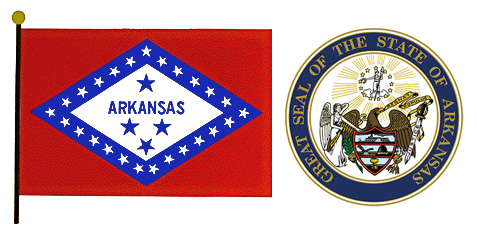
Amendments (changes) to the Constitution may be proposed in three ways. Legislative amendments are introduced by members of the state legislature. They must be approved by a majority of each house of the legislature. Initiative amendments are introduced through petitions signed by a specified number of voters. Every amendment must be approved in an election by a majority of the voters who cast ballots on the amendment.
Executive.
The governor of Arkansas serves a four-year term and may serve no more than two terms.
Other elected state officers are the lieutenant governor, secretary of state, attorney general, treasurer, auditor, and land commissioner. These officials are also elected to four-year terms and may serve no more than two terms. The governor appoints the adjutant general (commander) of the Arkansas National Guard and the heads and members of various departments and commissions. Many of these appointments must be approved by the state Senate.
Legislature,
called the General Assembly, consists of a 35-member Senate and a 100-member House of Representatives. Each of the state’s 35 senatorial districts elects one senator. Each of the 100 representative districts elects one representative. Senators are elected to four-year terms. Representatives are elected to two-year terms. Legislators can serve any number of terms, but no more than 12 consecutive years. 
Regular legislative sessions begin on the second Monday in January of odd-numbered years. These sessions last up to 60 calendar days unless extended by a two-thirds vote of both houses of the legislature. Fiscal legislative sessions begin on the second Monday in February of even-numbered years. Fiscal sessions last up to 30 calendar days unless extended by a three-fourths vote of both houses of the legislature. The governor may call the legislature into special session, which has no time limit.
In 1965, a federal district court ordered the state Board of Apportionment to reapportion (redivide) the legislature to provide equal representation based on population. The governor, secretary of state, and attorney general make up the Board of Apportionment. The board drew reapportionment plans for the House and Senate. The federal district court and the Supreme Court of the United States approved the plans. The state Board of Apportionment has reapportioned the Arkansas legislature after every federal census since 1970.
Courts.
The highest court in Arkansas is the state Supreme Court. It consists of a chief justice and six associate justices, all elected to eight-year terms. The Court of Appeals hears appeals from circuit courts. It has a chief judge and 11 associate judges, all elected to eight-year terms. The state is divided into 23 circuit court districts. Voters from these districts elect circuit court judges to six-year terms.
Other Arkansas courts include district and city courts. These courts hear minor civil and criminal cases.
Local government.
Each of the state’s 75 counties is administered by the county judge. The judge approves county expenditures and is the chief executive officer of the county. The judge also presides over the Quorum Court, a legislative group whose duties include approving the county budget. Quorum Court members are elected to two-year terms. The county judge and county constitutional officers are elected to four-year terms. County constitutional officials include the assessor, the circuit clerk, the county clerk, the medical examiner or coroner, the sheriff, the surveyor, the treasurer, and the collector. Some counties have various combinations of these offices. For example, some counties combine the offices of the county and circuit clerks or those of the sheriff and collector. Counties may reorganize their governments by vote of the people.
Most Arkansas cities have the mayor-council form of government. Some cities use the council-manager or city administrator forms.
Revenue.
Taxes are the largest source of the state government’s general revenue (income). They account for about half of the state’s general revenue. They include corporate and individual income taxes, a general sales tax, license fees, and taxes on alcoholic beverages, motor fuels, and tobacco products. Federal grants are the second largest source of revenue. They account for about a third of the state’s general revenue.
Politics.
The Democratic Party controlled Arkansas politics from the late 1800’s until the 1960’s. From 1874 until 1966, no Republican was elected governor of the state nor elected to a seat in the U.S. House of Representatives. In addition, from the 1870’s until 1996, no Republican was elected to the U.S. Senate from Arkansas. However, the Republican Party has gained strength in the state since the 1960’s.
In the 1968 presidential election, the state failed to support a Democratic presidential candidate for the first time in 100 years. Republican support has steadily increased since that time. Voters supported Democratic Arkansas native Bill Clinton, however, in his successful campaigns for president in the 1990’s.
History
Early days.
Native Americans lived in the Arkansas region about 12,000 years ago. European explorers found three principal tribes—the Caddo, Osage, and Quapaw—in the region.
Exploration and settlement.
In 1541, Hernando de Soto, a Spanish explorer, led an expedition that reached Arkansas. The Europeans failed to find the gold they were searching for, but historians believe the expedition introduced diseases that killed much of the Indigenous (native) population. In 1673, Father Jacques Marquette and Louis Jolliet of France traveled down the Mississippi to the mouth of the Arkansas River, where they met the Quapaw tribe. In 1682, René-Robert Cavelier, Sieur de La Salle, claimed the Mississippi Valley for France. La Salle made a grant of land to Henri de Tonty, who built a trading station called the Post of Arkansas (also known as Arkansas Post), near the mouth of the Arkansas River in 1686. 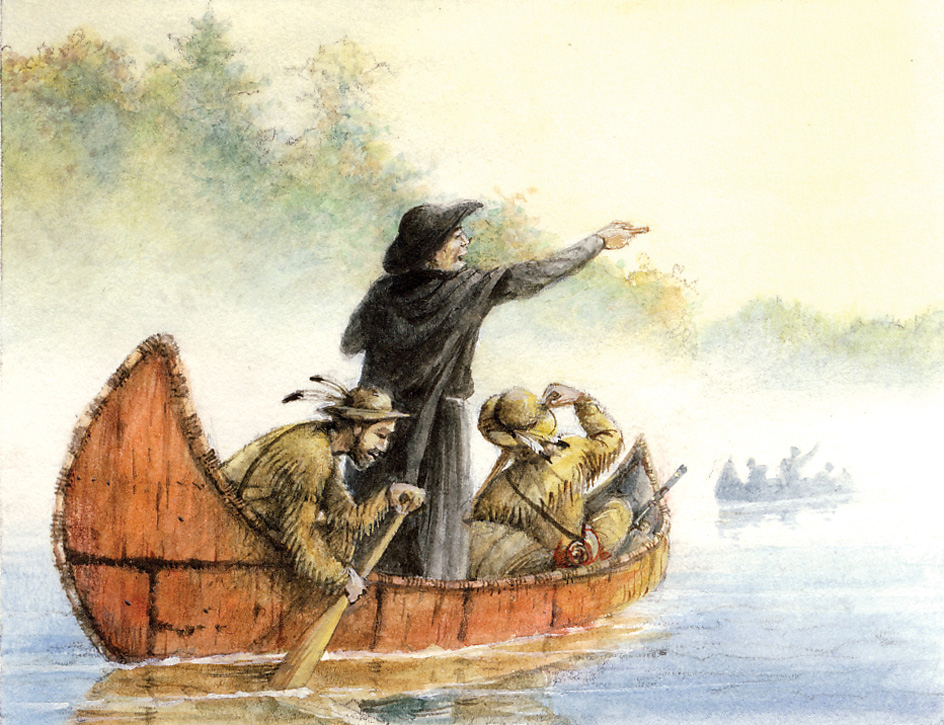
In 1717, France gave exclusive trading rights in Louisiana to Scottish banker John Law. To finance his company, Law developed a plan called the “Mississippi Scheme” (see Mississippi Scheme). Law’s company eventually collapsed in a financial disaster called the “Mississippi Bubble.” But the scheme brought many settlers to Louisiana. About 100 Europeans and a few enslaved Africans settled near the Post. Most of the settlers left, but some farmers remained.
In 1762, during the French and Indian War, France ceded to Spain the land west of the Mississippi River. This land included the Louisiana Territory. In 1800, Spain transferred the Louisiana Territory back to France. In 1803, the United States bought the Louisiana Territory from France. See Louisiana Purchase.
Territorial years.
In 1812, the southern part of the Louisiana Territory was made the state of Louisiana. The northern part, including Arkansas, became the Missouri Territory. In 1817, the U.S. government established Fort Smith in what is now northwestern Arkansas to keep peace among Native American tribes in the region. In 1819, the government created the Arkansaw Territory. It included present-day Arkansas and part of what is now Oklahoma. The town of Fort Smith grew up around the fort of the same name. Van Buren developed nearby. The town of Washington (now a state park) became an important stopping point for people traveling to Texas.
In the 1800’s, northwestern Arkansas became a temporary home to large numbers of Cherokee. But the Cherokee and other eastern tribes were forcibly moved to Indian Territory (present-day Oklahoma) during the 1830’s (see Trail of Tears).
Statehood and the Civil War.
On June 15, 1836, Arkansas was admitted to the Union as the 25th state. The nation was then engaged in a great debate over the question of slavery. By 1860, Arkansas had a white population of 435,450 and about 110,000 enslaved Black people. Many enslaved people worked on cotton plantations in the Arkansas lowlands. 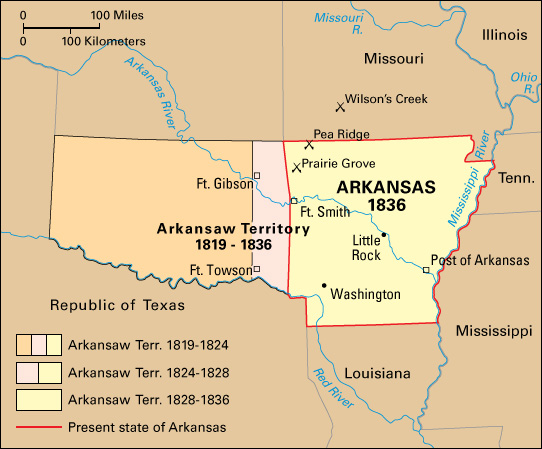
Abraham Lincoln, who opposed slavery, was elected president in 1860. Several Southern slave states then seceded (withdrew) from the Union and formed the Confederacy. Arkansas voters at first rejected secession, but the state joined the Confederacy soon after the Civil War began on April 12, 1861.
Arkansas sent troops to fight in Missouri at the Battle of Wilson’s Creek in August 1861. The Confederates won the battle. The Union Army entered the state and defeated the Confederates at the Battle of Pea Ridge in March 1862. In November 1862, Union soldiers defeated the Confederates at the Battle of Prairie Grove.
On Sept. 10, 1863, the Union Army took Little Rock. The Confederates then moved their capital to Washington in southwestern Arkansas. In 1864, Arkansans loyal to the Union wrote a new state constitution, establishing a Union government in Little Rock and abolishing slavery. But much of the state was not controlled by either the Union or the Confederacy. Lawless bushwhackers robbed and murdered many people.
Reconstruction.
During the Reconstruction period that followed the war, ex-Confederates dominating the Arkansas legislature refused to rejoin the Union. The U.S. Congress put Arkansas under military control. Federal troops occupied the state from 1867 to 1874.
Arkansas was readmitted to the Union in 1868. In that year, the state adopted a new constitution, giving Black men the right to vote but denying it to ex-Confederates. The Republican government tried to speed economic development, establish schools, and protect the civil rights of formerly enslaved people. Violence broke out between Republicans and Democrats and between white and Black people. Anti-Black groups such as the Ku Klux Klan spread terror.
In 1872, two Republicans clashed in the contest for governor. Elisha Baxter defeated Joseph Brooks, but Brooks charged fraud and claimed that he had won. On April 15, 1874, Brooks forced Baxter to leave the Statehouse at gunpoint. Rival supporters of the men clashed in what was called the Brooks-Baxter War. On May 15, 1874, President Ulysses S. Grant proclaimed Baxter the governor. Later in 1874, the state adopted a new constitution, which, though much amended, is still in use.
The late 1800’s.
New railroads crisscrossed Arkansas in the late 1800’s. Timber companies moved to the state to harvest the rich forest resources. New levees along the rivers and drainage ditches produced a land boom in the Delta. Bauxite was discovered near Little Rock in 1887, and mines opened.
The early 1900’s
brought continued development. Improved schools, medical care, and other government services were available at least in the towns. Rice growing was introduced in eastern Arkansas and began to replace cotton. In 1921, oil was found near El Dorado. The state’s first large hydroelectric dam was built in 1924.
However, agricultural prices fell after 1920, and many Arkansans lost their farms. The state was also affected by a destructive Mississippi River flood in 1927, by a drought in 1930, and by the Great Depression of the 1930’s. In 1934, after the price of cotton fell below the cost of production, some rebellious Arkansas farmers organized the short-lived Southern Tenant Farmers Union at Tyronza. But conditions remained poor for tenant farmers and sharecroppers.
In 1932, an Arkansas woman, Hattie Caraway, became the first woman elected to the United States Senate. She won a special election held shortly after the death of her husband, U.S. Senator Thaddeus Caraway. 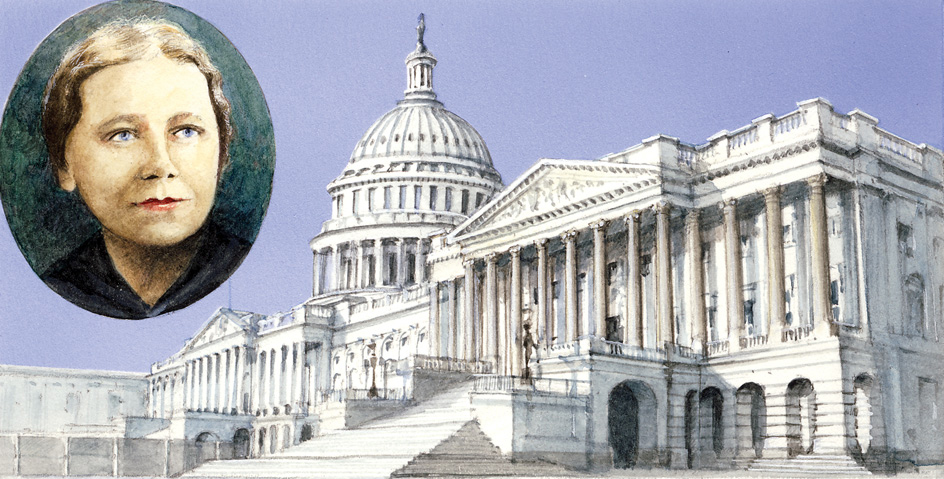
The mid-1900’s.
Farming and mining expanded in Arkansas during World War II (1939-1945). Soon after the war, the state began to shift from an agricultural to an industrial economy. Many farmworkers were replaced by the increased use of farm machinery. Manufacturing grew, but not fast enough to provide jobs for all the unskilled workers. Many left Arkansas to find jobs in other states. In spite of these problems, the number of Arkansas manufacturing plants more than doubled during the 1940’s and 1950’s. A number of plants were attracted to the state by the Arkansas Industrial Development Commission, which was established in 1955.
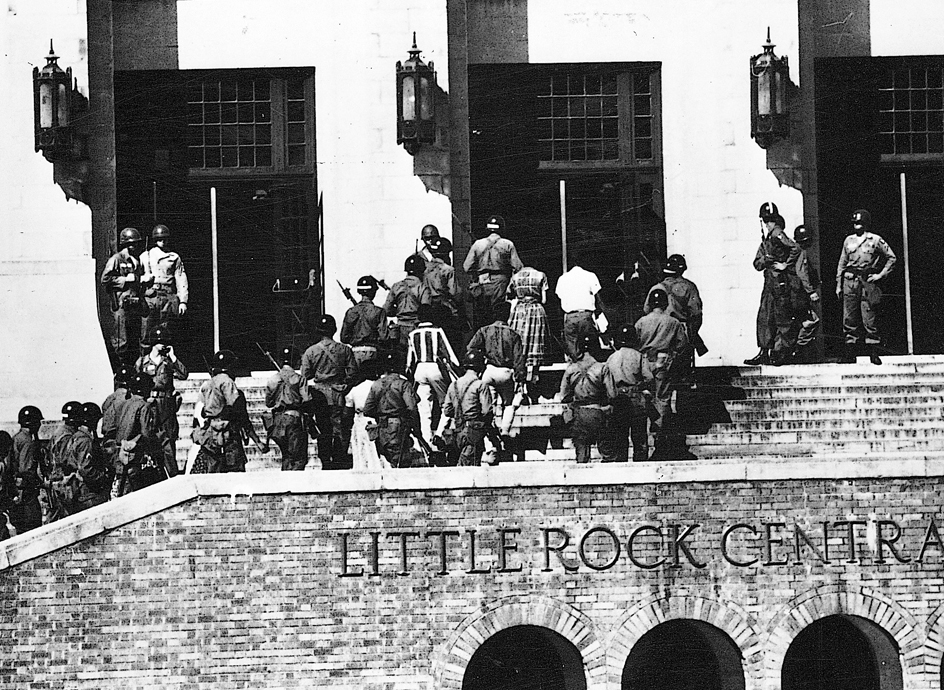
In 1957, Arkansas became a center of the controversy over school integration. The Supreme Court of the United States had ruled in 1954 that compulsory segregation in public schools was unconstitutional. In 1957, a federal court ordered Central High School in Little Rock to integrate. Governor Orval E. Faubus sent the Arkansas National Guard to block integration. President Dwight D. Eisenhower then put the National Guard under federal control and sent U.S. Army troops to enforce the court order. By 1970, most Arkansas schools and other public facilities were integrated to some extent.

In the 1960’s, Arkansas’s manufacturing income exceeded its farm income for the first time. Faubus was reelected governor in 1964 to a sixth consecutive term. No other Arkansas governor had served more than three terms. In 1967, Winthrop Rockefeller became Arkansas’s first Republican governor since Reconstruction days.
The late 1900’s.
The Arkansas River Development Program was completed in 1970. The development, renamed the McClellan-Kerr Arkansas River Navigation System, opened the river to navigation across the state from the Mississippi River into Oklahoma.
Bill Clinton, a Democrat who had been elected governor of Arkansas five times, was elected president of the United States in 1992 and reelected in 1996.
In May 1996, Governor Jim Guy Tucker of Arkansas was convicted of conspiring to defraud financial institutions and win illegal loans. He resigned from office and was sentenced to probation and community service.
The early 2000’s.
Today, Arkansas faces such tasks as reducing air and water pollution, providing enough energy for the state, improving its public education, and strengthening its unstable farm economy. State officials have succeeded in some attempts to promote trade with other countries and to attract new industry. The northwest part of the state has thrived, and retirees have found the region attractive. However, many Delta counties have lost population.
Arkansas has made repeated attempts to bring its schools up to the national average, but problems of funding remain. Private schools and home-schooling have increased in popularity. New junior colleges and new branches of existing colleges have expanded educational opportunities.
